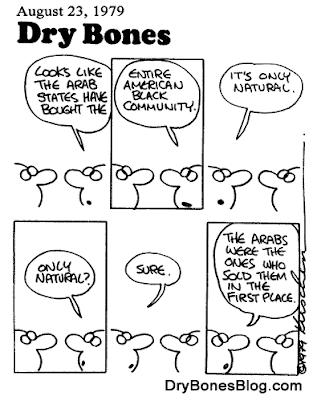One State for one People. Thou shalt not be a victim, or perpetrator, but above all, thou shalt not be a bystander. Yasher Koach!
February 28, 2014
If I am I because you are you.....
“If I am I because you are you, and you are you because I am I, then I am not I and you are not you. But if I am I because I am I, and you are you because you are you, then I am I and you are you.”
"A righteous man falls down seven times and gets up." – King Solomon, Proverbs, 24:16.
Life is all about the ability to get up from challenge.
Greatness is defined as getting up one more time than what you've fallen down.
The Torah defines someone who's righteous not as someone who had succeeded, but someone who has persevered.
It creates a paradigm of what righteousness is – trying to do what's right, getting up from failure, and keep moving forward - Charlie Harary
Kodesh HaKadashim -The Holy of Holies - Chabad
The Holy of Holies, as its name implies, was the most sacred part of the entire Temple. Entry was forbidden except on Yom Kippur when the High Priest entered the Inner Sanctuary.
 Its
dimensions were 20 cubits long, 20 cubits wide, and 40 cubits high. The
floor, walls, and ceiling were plated with gold, as was the Kodesh.
Its
dimensions were 20 cubits long, 20 cubits wide, and 40 cubits high. The
floor, walls, and ceiling were plated with gold, as was the Kodesh.
In the Holy of Holies was a rock that projected above the ground to a height of 3 fingers. The rock was first uncovered by King David and the prophet Samuel.
Some say the rock was in the very center of the Holy of Holies; others say it was near the western wall of the Holy of Holies, and still others maintain that it was near the curtains separating the Kodesh and the Holy of Holies.
The Ark (which contained the tablets with the Ten
Commandments) rested upon the rock during the First Temple era. During
the Second Temple there was no Ark. Some say it was captured by Nebuchadnezzar;
others say it was hidden beneath the rock; and still others say that it
was hidden below the Wood Chamber in the Women's Courtyard.
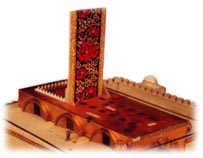 There
was another floor level above the Kodesh and Holy of Holies whose
dimensions and decorative work were exactly like the chambers below, but
with no curtains separating the floor above the Kodesh from from the
floor above the Holy of Holies. Instead stone blocks projected from the
wall itself to mark the division between the two sacred areas.
There
was another floor level above the Kodesh and Holy of Holies whose
dimensions and decorative work were exactly like the chambers below, but
with no curtains separating the floor above the Kodesh from from the
floor above the Holy of Holies. Instead stone blocks projected from the
wall itself to mark the division between the two sacred areas.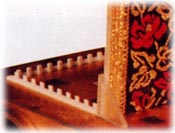 The
floor of the chamber above the Holy of Holies had trapdoors surrounding
the walls of the room. A large box supported by a rope, could be
lowered through any trapdoor down into the Holy of Holies. Workers who
had to repair the walls of the Holy of Holies were lowered through the
trapdoors into the chamber below. Their view of the Holy of Holies was
completely blocked off except for the portion of the wall to be
repaired.
The
floor of the chamber above the Holy of Holies had trapdoors surrounding
the walls of the room. A large box supported by a rope, could be
lowered through any trapdoor down into the Holy of Holies. Workers who
had to repair the walls of the Holy of Holies were lowered through the
trapdoors into the chamber below. Their view of the Holy of Holies was
completely blocked off except for the portion of the wall to be
repaired.Kodesh - The Inner Sanctuary - Chabad
The Kodesh - Inner Sanctuary
The doorway of the Kodesh was 10 cubits wide and 20 cubits high. Over the doorway was a carving of a golden menorah donated by Queen Helena, a convert to Judaism.
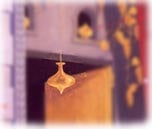 The
morning service could not begin before sunrise. The Temple was
surrounded by high walls, and it was not possible to see the rising sun,
so a priest had to be sent outside to see if it was time for the
service to begin.
The
morning service could not begin before sunrise. The Temple was
surrounded by high walls, and it was not possible to see the rising sun,
so a priest had to be sent outside to see if it was time for the
service to begin.
 The Doorway
The Doorway
 The Windows
The windows of the Kodesh were 20 cubits high, and consisted of long
narrow openings in the walls. The openings were wider on the outside
than on the inside. In a private dwelling, window openings were narrow
on the outside and wide on the inside to cause the light to spread
inside. The rabbis viewed the Heichal as the "light source" of the
world, so the windows were constructed thus to spread the light outward.
The Windows
The windows of the Kodesh were 20 cubits high, and consisted of long
narrow openings in the walls. The openings were wider on the outside
than on the inside. In a private dwelling, window openings were narrow
on the outside and wide on the inside to cause the light to spread
inside. The rabbis viewed the Heichal as the "light source" of the
world, so the windows were constructed thus to spread the light outward.
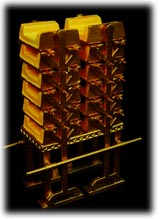 The Holy Vessels
Near the northern wall of the Kodesh was the Shulchan (Golden Table).
It was placed in an east-west orientation. On the Table were the twelve
showbreads and two spoons filled with frankincense. There were the
other golden tables in the Kodesh; five north of the Golden Table, and
five to the south. These were to enhance the beauty of the Golden Table.
The Holy Vessels
Near the northern wall of the Kodesh was the Shulchan (Golden Table).
It was placed in an east-west orientation. On the Table were the twelve
showbreads and two spoons filled with frankincense. There were the
other golden tables in the Kodesh; five north of the Golden Table, and
five to the south. These were to enhance the beauty of the Golden Table.
 In the First Temple, a wall 1 cubit thick separated the Kodesh from the Holy of Holies.
In that Temple the ceiling was only 30 cubits, the Second Temple had a
height of 40 cubits between floor and ceiling. A wall 1 cubit thick
could not be erected to the 40 cubit height. They did not want to make a
wider wall so as not to diminish any area of the Kodesh or the Holy of
Holies.
In the First Temple, a wall 1 cubit thick separated the Kodesh from the Holy of Holies.
In that Temple the ceiling was only 30 cubits, the Second Temple had a
height of 40 cubits between floor and ceiling. A wall 1 cubit thick
could not be erected to the 40 cubit height. They did not want to make a
wider wall so as not to diminish any area of the Kodesh or the Holy of
Holies.
The doorway of the Kodesh was 10 cubits wide and 20 cubits high. Over the doorway was a carving of a golden menorah donated by Queen Helena, a convert to Judaism.
 The
morning service could not begin before sunrise. The Temple was
surrounded by high walls, and it was not possible to see the rising sun,
so a priest had to be sent outside to see if it was time for the
service to begin.
The
morning service could not begin before sunrise. The Temple was
surrounded by high walls, and it was not possible to see the rising sun,
so a priest had to be sent outside to see if it was time for the
service to begin.
After Queen Helena donated the Menorah, it was no longer
necessary to send a priest outside the Temple. As the sun rose in the
east it shone against the menorah and the reflected light was cast into
the Azarah. The priests then knew that the morning service could begin.
 The Doorway
The Doorway
The doorway was 6 cubits thick and had four doors. The
doors were made of olive wood overlaid with gold. Carved in the gold
were angels, palm trees, and flowers. The front walls of the Heichal and
the doorposts were 6 cubits thick.
Two doors were set at the front of the 6-cubit doorway,
and two doors were set at the rear. The front two doors opened inward,
and folded against the inner wall of the doorway.  The rear doors also opened inward, and folded against the wall. (R. Yehudah has a different opinion concerning the doors).
The rear doors also opened inward, and folded against the wall. (R. Yehudah has a different opinion concerning the doors).
 The rear doors also opened inward, and folded against the wall. (R. Yehudah has a different opinion concerning the doors).
The rear doors also opened inward, and folded against the wall. (R. Yehudah has a different opinion concerning the doors).
In front of the doors was a curtain that could be raised and lowered. When the High Priest was in the Kodesh, the curtain was lowered to afford him privacy.
 The Windows
The Windows
The Kodesh was 40 cubits long, 20 cubits wide and 40
cubits high. The walls were paneled with wood and overlaid with gold,
except for the places the doors covered when they were open. Engraved in
the gold were palm trees, vines, flowers, and angels.
 The Holy Vessels
The Holy Vessels
The Menorah was placed with a north-south orientation near the southern wall  of
the Kodesh, though some say it was placed with an east-west
orientation. There were ten other menorahs in the Kodesh. Five were
placed north of the Menorah, and five were placed to the south. These,
too, were from ornamental purposes.
of
the Kodesh, though some say it was placed with an east-west
orientation. There were ten other menorahs in the Kodesh. Five were
placed north of the Menorah, and five were placed to the south. These,
too, were from ornamental purposes.
 of
the Kodesh, though some say it was placed with an east-west
orientation. There were ten other menorahs in the Kodesh. Five were
placed north of the Menorah, and five were placed to the south. These,
too, were from ornamental purposes.
of
the Kodesh, though some say it was placed with an east-west
orientation. There were ten other menorahs in the Kodesh. Five were
placed north of the Menorah, and five were placed to the south. These,
too, were from ornamental purposes.
In the center of the Kodesh was the golden Altar. The
Menorah, Altar, and Table were placed within the inner half of the
Kodesh. The Altar was slightly off to the east.
 In the First Temple, a wall 1 cubit thick separated the Kodesh from the Holy of Holies.
In that Temple the ceiling was only 30 cubits, the Second Temple had a
height of 40 cubits between floor and ceiling. A wall 1 cubit thick
could not be erected to the 40 cubit height. They did not want to make a
wider wall so as not to diminish any area of the Kodesh or the Holy of
Holies.
In the First Temple, a wall 1 cubit thick separated the Kodesh from the Holy of Holies.
In that Temple the ceiling was only 30 cubits, the Second Temple had a
height of 40 cubits between floor and ceiling. A wall 1 cubit thick
could not be erected to the 40 cubit height. They did not want to make a
wider wall so as not to diminish any area of the Kodesh or the Holy of
Holies.
It was decided to build the Kodesh a full 40 cubits long
and the Holy of Holies a full 20 cubits. A neutral space of 1 cubit
would be place between them, and marked off by two curtains.
One curtain was placed between the end of the Kodesh and
the beginning of the cubit space. The other curtain was placed between
the end of the cubit space and the beginning of the holy of Holies. The
outer curtain was folded back on its southern side and the inner curtain
folded back on its northern side.
The curtains were never opened except during festivals,
when they were rolled back so that the people could see the carvings of
the angels on the wall. The angels in the carvings were embracing, which
represented the love of G-d to the children of Israel.
Ta'im - The Small Offices - Chabad
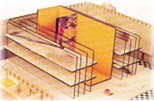 Ta'im - The Small Offices
Ta'im - The Small Offices Along the northern, western, and southern outside walls of the Kodesh (Inner Sanctuary) and Holy of Holies were a series of small offices. These offices were not used for storage, their only purpose was to serve as an additional divider for the Inner Sanctuary and the Holy of Holies.
There were fifteen offices to the north and fifteen to
the south, five per floor. There were eight small offices to the west,
three at the bottom level, three atop them, and two atop them.
 The
height of the three stories of offices covered about half the height of
the outside walls. The remaining height had windows set into the walls
to allow light to enter. The holy of Holies had one window in the back
wall, 8 cubits high.
The
height of the three stories of offices covered about half the height of
the outside walls. The remaining height had windows set into the walls
to allow light to enter. The holy of Holies had one window in the back
wall, 8 cubits high.
Steps in each office led to the floor above and the
floor below. Doors led into the adjacent offices. The bottom level of
offices was built alongside the foundation, not above it.
The Offices' Entrance
The Ulam - (Entrance hall) - had doors that led into the first office along the northern wall and into the first office along the southern wall.
The Ulam - (Entrance hall) - had doors that led into the first office along the northern wall and into the first office along the southern wall.
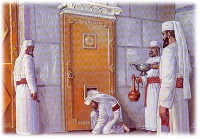 The door leading to the first southern office was never opened by any priest. However, on the Sabbath, festivals, and at the moment the new moon appeared, the door would open by itself.
The door leading to the first southern office was never opened by any priest. However, on the Sabbath, festivals, and at the moment the new moon appeared, the door would open by itself.
Since the first floor of offices was located at the
foundation level, these two doors in the Hall must have led into the
first office on the second floor.
 The Northern Door
The Northern DoorTo allow a person to stand in the Hall and open the door leading into the first northern office - an opening was located in the lower part of the door.
The priest of Levite had to bend down, insert his hand through the opening, and, with a key, unlock the door from the inside.
Inside that office was another doorway leading into the
Kodesh. That door unlocked in a more conventional way. Once inside the
Kodesh, the Kodesh doors could be unlocked. The locks to these doors
were on the inside of the doors.
 The Ramp
The RampThe first northern office also had a door in its northern wall, which led to the bottom of a ramp. The ramp led up to the roof of the western offices. One could walk along that roof, headed south, until he came to the southern side of the Heichal.
 There
was another ramp along the southern side of the Heichal, on the roof of
the southern offices, that led to a door into the chamber above the
Kodesh. Only workmen who had to do repair work went into the upper
chamber.
There
was another ramp along the southern side of the Heichal, on the roof of
the southern offices, that led to a door into the chamber above the
Kodesh. Only workmen who had to do repair work went into the upper
chamber.
The Cistern
Behind the southern wall of the southern offices was a cistern. The water that flowed off the roof of the Heichal ran into that cistern.
Behind the southern wall of the southern offices was a cistern. The water that flowed off the roof of the Heichal ran into that cistern.
The first northern office had a door in its northern
wall, which led to the bottom of a ramp. The ramp led up to the roof of
the western offices. One could walk along that roof, headed south, until
he came to the southern side of the Heichal.
There was another ramp along the southern side of the
Heichal, on the roof of the southern offices, that led to a door into
the chamber above the Kodesh. Only workmen who had to do repair work
went into the upper chamber.
Ulam - The Entrance Hall - chabad
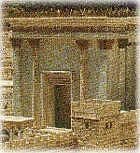 Ulam - The Entrance Hall
Ulam - The Entrance HallThis entrance hall which lead to the inner sanctuary was called the Ulam. It is described by most commentaries as 100 cubits from north to south, 100 cubits high and 11 cubits from east to west.
It was one story high. Inside, chains were suspended from the ceiling to the ground, this way young Kohanim could inspect the walls and windows for repairs - by climbing the chains.
Beams of cedar connected the front and back walls and served as braces to keep the high walls from toppling.
The Doorway
The doorway was 6 cubits thick and had four doors. The doors were made of olive wood overlaid with gold. Carved in the gold were angels, palm trees, and flowers. The front walls of the Heichal and the doorposts were 6 cubits thick.
Two doors were set at the front of the 6-cubit doorway,
and two doors were set at the rear. The front two doors opened inward,
and folded against the inner wall of the doorway. The rear doors also
opened inward, and folded against the wall. (R. Yehudah has a different opinion concerning the doors).
In front of the doors was a curtain that could be raised and lowered. When the High Priest was in the Kodesh, the curtain was lowered to afford him privacy.
Chamber of the Knives At the northern and southern ends of the Ulam were two rooms called the
 Beit
Hachalifot - Chamber of Knives. The slaughtering knives were kept here
in lockers set into the wall. The dull or defective knives were kept in
the southern room, where they were sharpened or repaired. Knives
suitable for use were stored in the northern room.
Beit
Hachalifot - Chamber of Knives. The slaughtering knives were kept here
in lockers set into the wall. The dull or defective knives were kept in
the southern room, where they were sharpened or repaired. Knives
suitable for use were stored in the northern room.Small Gates
 In
the southwest and northwest corner of the Ulam were doors 8 cubits
high. Since all korbanot (sacrifices) had to be slaughtered opposite
"the door of the Heichal" - as described in the Torah,
In
the southwest and northwest corner of the Ulam were doors 8 cubits
high. Since all korbanot (sacrifices) had to be slaughtered opposite
"the door of the Heichal" - as described in the Torah,- these two doors were built so that slaughtering done anywhere in the Azarah would be "opposite the door".
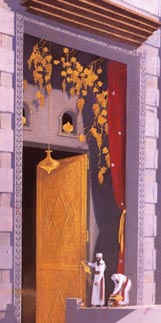 The Great Doorway
The Great DoorwayThe doorway to the hall was 20 cubits wide and 40 cubits high, and was the largest doorway in the Temple.
Above the doorway were five great mahogany beams set into the face of the building (Middot 3:7), each carved with ornate designs. The bottom beam was set directly above the doorway and was 22 cubits long, extending beyond the doorway 1 cubit on each side.
So it was with the other beams up to the fifth beam, which was 30 cubits long. Set between the beams were rows of stones projecting from the wall to further enhance the appearance of the entrance.
 The
large doorway had no doors, but rather a large curtain of the finest
linen with fringes and gold flowers embroidered on it. (the door seen in
the picture lead to the Heichal.)
The
large doorway had no doors, but rather a large curtain of the finest
linen with fringes and gold flowers embroidered on it. (the door seen in
the picture lead to the Heichal.)Yachin and Bo'az
Flanking this entrance were two large copper columns. Each was 18 cubits high, 12
 cubits
in circumference, 2/3 of a cubit thick and had a capital on top,
measuring 5 cubits high with carvings of flowers and lilies.
cubits
in circumference, 2/3 of a cubit thick and had a capital on top,
measuring 5 cubits high with carvings of flowers and lilies.The right pillar was called Yachin, representing the kingdom of David forever-prepared (Yachin in Hebrew). The left pillar was called Boaz after the judicial ancestor of David.
Shaar Hamayim - Water Gate, and its adjacent chambers - Chabad
Shaar Hamayim - Water Gate, and its adjacent chambers
During the festival of Sukkot, the Kohanim drew water from the Shiloach Brook, and brought it through this gateway. The water gate was open only during the festival.
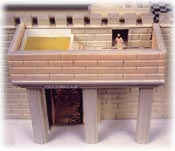 Mikvah - The Ritual Bath
Mikvah - The Ritual BathAbove the water gate was a mikvah. It was used only once a year, by the High Priest on Yom Kippur.
On that Holy Day, the High Priest immersed himself five times in a mikvah. The first immersion was done here. This mikvah above the water gate, may also have contributed to the Gate's name.
The water gate took its name as well from the narrow stream of water that flowed from beneath the foundations of the Heichal, across the courtyard, and out through the Water Gate.
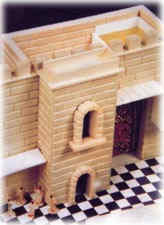 Lishkat Avtinus - The Avtinus Chamber
Lishkat Avtinus - The Avtinus Chamber
To the right of this gateway (inside the Azarah) was a chamber called the Lishkat Avtinus.
In this room, the incense that was offered on the golden Altar was compounded. The chamber was named after an illustrious family of spice makers. They knew of a certain ingredient, which, when added to the incense, made the smoke rise in a straight column. They refused to divulge the name of this ingredient lest others use it for idol worship.
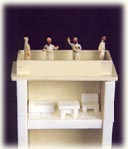 During
the Second Temple period, the High Priesthood was a political
appointment based on reasons other than merit. Often the priest was
unable to read Hebrew.
During
the Second Temple period, the High Priesthood was a political
appointment based on reasons other than merit. Often the priest was
unable to read Hebrew.It was in this Chamber of Avtinus that he was taught how to present the special Yom Kippur incense offering, which was burnt in the Holy of Holies.
In Addition to the Water Gate, the Southern side of the Temple also had several additional gateways: 1) Sha'ar HaBechorot - Gate of the Firstborn; 2) Sha'ar HaDelek - The Firewood Gate and 3) Sha'ar HaElyon - The Upper Gate.
Sha'ar HaBechorot - Gate of the firstborn
The firstborn offering was one of the more common sacrifices of lesser sanctity and was therefore brought into the Temple through a southern gate -- to indicate its relative unimportance.
Some say that when Abraham brought Isaac, his firstborn, to be sacrificed upon the mount he walked over this area.
The forests of Jerusalem were located west of the Upper City. The wood was cut down and brought in through the Kiphonus Gate, the only gate on the western side of the Temple wall to lead directly onto the Temple Mount.
The wood could not be brought in through the western gates surrounding the Azarah, because those gates were narrow and small.
The wood had to be carried around to the southern part
of the Azarah and brought in through one of those gateways, which was
called the Gate of the Firewood.
The firewood from the Wood Chamber was also brought into the Azarah through the Gate of the Firewood.
Sha'ar HaElyon - Upper Gate
The upper gate - not to be confused with the Nikanor
Gate that was also called the Upper Gate - was the highest point on the
Temple Mount.
Mizbe'ach Ha'Chitzon - The Great Altar - Chabad
This Altar served a variety of uses. The top was used to burn the various sacrifices offered in the Bet Hamikdash.
The walls of the Mizbe'ach were used for the "Zerikat HaDam" (sprinkling the blood of certain sacrifices) as established by the Torah. It was accessed by a series of ramps, built on its southern side.
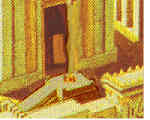 The
Altar was made of small stones, lime, pitch, and glazing. The stones
were perfectly smooth, with no nicks or scratches that could be detected
with the thumbnail. These stones were never touched by metal, because
metal is believed to shorten the life of man, and the Altar represents
the lengthening of life.
The
Altar was made of small stones, lime, pitch, and glazing. The stones
were perfectly smooth, with no nicks or scratches that could be detected
with the thumbnail. These stones were never touched by metal, because
metal is believed to shorten the life of man, and the Altar represents
the lengthening of life.The Outer Mizbe'ach consisted of three platforms stacked to form a square pyramid.
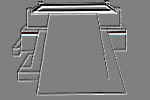
To the south of the Mizbe'ach stood a large ramp, which enabled the Kohanim (priests) to ascend to the Altar's roof There were also two smaller ramps, that led to a ledge which surrounded the Altar.
This ledge was called the Sovev - "around" as it was possible to circle the Altar using this ledge. (The additional ledge lower down, did not completely surround the Altar)
 The Red Line
The blood of certain sacrifices was spilled on the upper part of the
Altar's wall. While the blood of the other sacrifices was poured onto
the lower half. To separate the two levels, a red band (Chut Hasikrah in
Hebrew), surrounded the Mizbe'ach at mid-height. To further emphasize
this border, there was a floral design above the red line.
The Red Line
The blood of certain sacrifices was spilled on the upper part of the
Altar's wall. While the blood of the other sacrifices was poured onto
the lower half. To separate the two levels, a red band (Chut Hasikrah in
Hebrew), surrounded the Mizbe'ach at mid-height. To further emphasize
this border, there was a floral design above the red line.On top of the south western corner of the yesod, the base, two drains were carved. The blood remaining from the 'spilling of the blood' service, was poured into these drains.
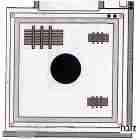 Makom Hama'aracha - The Place of Arrangement Three stacks of lumber were arranged on the Altar's platform:
Makom Hama'aracha - The Place of Arrangement Three stacks of lumber were arranged on the Altar's platform:(1) The Large Arrangement - used for burning the animal sacrifices.
(2) Fuel for the burning of the Ketoret, offered twice daily on the small Mizbe'ach (Mizbe'ach Hazahav).
(3) Wood lit by the Kohanim to perform the Mitzvah of igniting the Altar every morning.
In the center of the platform was a large pile of ash that accumulated from the remains of sacrifices. It was called 'the Apple' because of its fruit-like appearance.
The Cornerstones
The Altar had four cornerstones which were hollow and open to the top. Their dimensions were an amah by an amah, and five tefachim high.
There were also two basins built onto the southwestern portion of the platform. They were used on the festival of Succot for the Water Drawing ceremony.
The Three Northern Chambers - Chabad
This roofed building contained 3 separate chambers:

(1) Lishkat Hagazit - Chamber of Hewed Stone
This chamber built with hewed stone served as the
Supreme Court. Since it was forbidden to sit in the Azarah, the building
was built half way in the Azarah and half way in the Cheil, and had
entrances from both sides. Half of the building was built outside the
Azarah where the judges would be allowed to sit.
(2) Lishkat Hagolah - The Chamber of the Well
A water wheel located in this chamber supplied a quick drink for the thirsty Kohanim. The Jews who came from the exile (Golah) dug this well.
(3) Lishkat Parhedrin - Chamber of the High Priest (Kohen Gadol)
Seven days before Yom Kippur, the High Priest would leave his mansion and family in the upper city and take up residence in this chamber. He would be instructed in the Yom Kippur service by the supreme court members and by the priestly scholars.
Parhedrin were government officials appointed for 1-year terms. This room was so named because during most of the 2nd Temple era, the High Priest who resided in this room was changed from year to year.
Seven days before Yom Kippur, the High Priest would leave his mansion and family in the upper city and take up residence in this chamber. He would be instructed in the Yom Kippur service by the supreme court members and by the priestly scholars.
Parhedrin were government officials appointed for 1-year terms. This room was so named because during most of the 2nd Temple era, the High Priest who resided in this room was changed from year to year.
The Butchering Area - Chabad
North of the Altar was the Butchering Place where the sacrificial animals were slaughtered and butchered. It included:
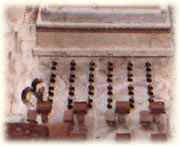
The Eight Columns
In the northern section of the Butchering Place were eight small columns. Resting on each column was a block of cedar wood with nine hooks attached to it. The slaughtered carcass of the sacrificial animal was hung on these hooks in order to remove the skin and butcher the animal.
The hooks were set into the northern side of the wood, three on the eastern side, and three on the southern side. There were no hooks on the western side, so that the priest did not have to turn his back to the Holy of Holies as he was butchering the animal.
The Eight Tables
Nearby were eight tables that served several purposes. The meat was washed on these tables before it was cooked and eaten by the priests. The animal parts offered on the Altar also had to be washed. The tables kept the carcass from touching the ground as it was being butchered. These tables could fold so they could be moved around as needed.

The Twenty-four Hoops
North of the Altar were twenty-four hoops set into the ground. During the earlier years of the Second Temple, the priest would make a slit in the animal's forehead before slaughtering it. The painless incision caused blood to flow, distracting the animal.
The High Priest Yochanan abolished the practice, lest it might be thought that the slit constituted a blemish and the Temple was offering blemished animals. He decreed that hoops be set into the ground, and the animal's head be inserted to keep it steady.

The Eight Columns
In the northern section of the Butchering Place were eight small columns. Resting on each column was a block of cedar wood with nine hooks attached to it. The slaughtered carcass of the sacrificial animal was hung on these hooks in order to remove the skin and butcher the animal.
The hooks were set into the northern side of the wood, three on the eastern side, and three on the southern side. There were no hooks on the western side, so that the priest did not have to turn his back to the Holy of Holies as he was butchering the animal.
The Eight Tables
Nearby were eight tables that served several purposes. The meat was washed on these tables before it was cooked and eaten by the priests. The animal parts offered on the Altar also had to be washed. The tables kept the carcass from touching the ground as it was being butchered. These tables could fold so they could be moved around as needed.

The Twenty-four Hoops
North of the Altar were twenty-four hoops set into the ground. During the earlier years of the Second Temple, the priest would make a slit in the animal's forehead before slaughtering it. The painless incision caused blood to flow, distracting the animal.
The High Priest Yochanan abolished the practice, lest it might be thought that the slit constituted a blemish and the Temple was offering blemished animals. He decreed that hoops be set into the ground, and the animal's head be inserted to keep it steady.
The Three Southern Chambers - Chabad
3 Southern Chambers
This building complex consisted of three chambers:
This building complex consisted of three chambers:
 Lishkat Hamelach - The Salt Chamber
Lishkat Hamelach - The Salt Chamber
This chamber was used to store and prepare the salt necessary for the Korbanot (sacrifices). It was necessary to sprinkle salt on all the Korbanot offered on the Altar. They would also sprinkle the Ramp to the Altar with salt to prevent slipperiness on rainy days.
Lishkat Haparvah - The Parvah Chamber
Here they would salt and process the animal hides of the Korbanot.
Here they would salt and process the animal hides of the Korbanot.
On the roof was a Mikvah (ritual bath) constructed for the exclusive use of the High Priest on Yom Kippur. Some say that the man who built this chamber dug a tunnel beneath the Kodesh Hakodashim (Holy of Holies)
so that he could observe the High Priest's services there on Yom
Kippur. When he was discovered, he was executed in this chamber, which
was later named after him.
Lishkat Hamadichin - the Rinser's chamber
Here they would rinse and clean the internal organs of
the Korbanot. Although these animals were offered on the Altar - and not
meant for human consumption, they were nevertheless rinsed and cleaned
as a gesture of respect and reverence to G-d.
Bet Hamoked - The Hearth - Chabad
The largest building in the Azarah was the Heichal,
which will be discussed later. The second largest was the Hearth. This
dome-covered structure was the sleeping quarters for the priests who
performed the services.
Most authorities say that it was half inside the Azarah and half outside. It had four rooms connected with the structure.
Some say that the side rooms were outside the building.
Others say that the four side rooms were inside the building, one room
in each corner.
The Hearth itself served as a dormitory. The walls were
lined with great stone steps. Some sources say the priests slept on
these steps, while others maintain that the sleeping quarters were built
into the wall, like cubicles or coops.
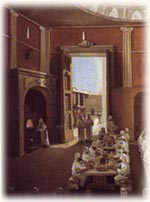 The
priests would climb the steps to their respective cubicles, the elder
priests slept above, and the younger ones slept on the floor.
The
priests would climb the steps to their respective cubicles, the elder
priests slept above, and the younger ones slept on the floor.
In the middle of the floor was a tile one cubit by one
cubit. It could be raised by lifting a hoop set into it. Underneath was a
chain, to which were attached the keys to the gates.
One of the priestly officials would take the keys after
the Temple doors were locked at night, place them on the chain, and
sleep atop the tile.
* * *
Four rooms were connected to the Hearth:
lishkat Lechem Hapanim - Chamber of the Showbread
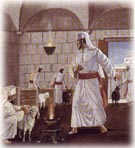 The twelve "showbreads" used for the Shulchan were baked here every Friday. On Shabbat the new showbreads replaced the older ones which were later eaten by the Kohanim in this room.
The twelve "showbreads" used for the Shulchan were baked here every Friday. On Shabbat the new showbreads replaced the older ones which were later eaten by the Kohanim in this room.
lishkat HaChosamot - The Receipt Chamber
When one needed oil, wine, or flour for his sacrifice, he purchased special tokens ("receipts") in this chamber. With these tokens he would pick up his order from the chamber of oils.
This room also contained the stones of the Mizbe'ach defiled by the Greeks.
When one needed oil, wine, or flour for his sacrifice, he purchased special tokens ("receipts") in this chamber. With these tokens he would pick up his order from the chamber of oils.
This room also contained the stones of the Mizbe'ach defiled by the Greeks.
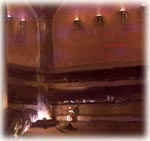 lishkat Hatela'im - The Sheep Chamber
lishkat Hatela'im - The Sheep ChamberThis chamber was used as a barn for the sheep offered as "daily sacrifices". The sheep were checked for blemishes and imperfections twice a day, for a four-day period prior to being sacrificed
lishkat Bet Hamoked - the Hearth Chamber
This was a chamber that led to another hearth underground used by Kohanim who were not ritually pure. A Mikvah (ritual bath) and restrooms were also located in this underground chamber.
Other Gates leading to the Northern side of the temple included the Sha'ar Hanitzutz - Gate of Sparks and the Sha'ar Hanashim - The Women's Gate.
In front of this gate was a small courtyard surrounded
by columns, which supported a balcony upon which kohanim from the
priestly guard stayed watch at night.
The sun's rays shining between the columns appeared to be flickering sparks, giving the gate its name.
The gate was also called Gate of Yoachim, because it was from this very spot that King Yoachim was led into exile by Nebuchadnezzar.
Women were required to bring a sacrifice after giving
birth, and on other occasions. They would stand in this gateway while
their sacrifice was being offered. This gateway was narrower than the
other gates on the north side.
Sha'ar Nikanor - Nikanor Gate - Chabad
Sha'ar Nikanor - Nikanor Gate
The Nikanor Gates led from the Ezrat Nashim to the Azarah. Fifteen semi-circular steps lead to this gate. On occasion, the Levites sang as they stood on these steps.
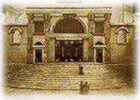 The Fifteen Steps
At the western end of the Women's Courtyard were fifteen semi-circular
steps. Each was half a cubit high and half a cubit deep. On occasion,
the Levites sang as they stood on these steps.
The Fifteen Steps
At the western end of the Women's Courtyard were fifteen semi-circular
steps. Each was half a cubit high and half a cubit deep. On occasion,
the Levites sang as they stood on these steps.Chamber of Instruments
 Near the base of the steps, built into the western wall
of the Women's Courtyard, were two doors that led underneath the
Azarah, which was built on higher ground than the Women's Courtyard.
Near the base of the steps, built into the western wall
of the Women's Courtyard, were two doors that led underneath the
Azarah, which was built on higher ground than the Women's Courtyard.
The doors led into a single large underground chamber
called the Chamber of Instruments. Here the Levites conducted choir
rehearsals and stored their instruments.
The doorway atop the fifteen semi-circular steps led into the Azarah. The first eleven cubits along the eastern side of the Azarah was called the Courtyard of the Israelites.
The gateway atop the fifteen steps that led into the Courtyard of the Israelites were called the Upper Gate, also known as the Nikanor Gate.
Nikanor was the benefactor who paid craftsmen in Alexandria, Egypt, to fashion the two large brass doors used for this gate.
Each door was 5 cubits by 20 cubits. The brass was carved with intricate designs, and its finish was exceedingly bright.
A Story:
As these doors were being sent by ship from Egypt to Judea, a storm broke out. The crew was forced to cast one of the two brass doors into the sea.
As these doors were being sent by ship from Egypt to Judea, a storm broke out. The crew was forced to cast one of the two brass doors into the sea.
When the danger continued, the crew decided to toss the
second gate out as well. Hearing their plans, Nikanor declared that if
they throw out the door, they should throw him out as well. His
self-sacrifice called for a miracle and the storm subsided. When the
ship docked, the door cast overboard was miraculously found floating in
the harbor.
All the Temple doors were plated with gold except the
Nikanor gate. The rabbis wanted the people to see the "miracle doors" in
their pristine form. Additionally, the brass finish had the appearance
of fine gold.
The heavy doors required twenty men to open them. The Nikanor Gate was opened only on the Sabbath, festivals, and Rosh Chodesh.
If the king was present in the Temple, the doors were also opened in
his honor. On all other days, smaller gateways (to the left and right of
Nikanor gate) were used.
The Ezrat Nashim - The Women's Courtyard - Chabad

This courtyard contained a balcony reserved for women - hence its name - the women's courtyard. Chambers were built in the four corners of this courtyard for various temple needs:
Lishkat Hanezirim - Chamber of the Nazarites; Lishkat
Ha'eitzim - Chamber of the Wood; Lishkat Hametzora'im - Chamber of the
Metzorah's; Lishkat Hashemanim - Chamber of Oils

Women's Balcony A gallery was reserved here
for women who came to view the Simchat Bet Hasho'eva (Rejoicing of the
Water Drawing Ceremony) which was held in this courtyard during the
festival of Succot.
To the North and South of the Ezrat Nashim (women's courtyard) were stairways leading to the Women's Balcony.
 Originally, the women assembled in the courtyard and the men danced and sang outside, beyond the Cheil.
Originally, the women assembled in the courtyard and the men danced and sang outside, beyond the Cheil.
Since the women were unable to have a good view from
inside the Women's Courtyard, they would pass beyond the doors into the
area. The mingling of men and women during a sacred celebration is not
permitted. To remedy the situation, balconies were erected to provide a
viewing area for the women.
Lishkat Hanezirim - Chamber of the Nazarites
A Nazarite
is one who takes an oath that he will not cut his hair or drink wine
(or any grape product) for a specified amount of time. The Torah
requires a Nazarite to bring 3 Karbanot (sacrifices) to the Bet
Hamikdash after fulfilling his pledge. One of these sacrifices, the
"Shelamim" offering was cooked in this chamber. The Nazarites then had
their hair clippings tossed into the fire over which the "Shelamim"
offering was cooking.
The Lumber used for the service of the Bet Hamikdash (i.e. for the altar and the "Beis Hamoked") was stored in this room.
In addition, elderly priest (or priests otherwise unfit
for the temple service) would examine the wood for worms here. If any
were found, the wood would be deemed unfit for temple use. [Rotting wood
would also be disposed of.]
The Talmud
records the following incident: It once happened that priests were
sitting and sorting wood in this Chamber, when one of them noticed that a
floor tile was loose. He realized that this led to the secret tunnel in
which the Holy Ark was hidden.
[The Ark had been hidden during the time of Yeshayahu (Isaiah)
towards the end of the First Temple era. When the Jews returned from
the seventy-year exile, the Ark could not be found. Tradition says that
there was to be no Ark during the Second Temple era.]
The priest, who had discovered the hidden place of the
Ark, sought to crack open the tile with his hatchet, when suddenly fire
issued forth and consumed him. This was taken as an omen that the Ark
should remain hidden.
Lishkat Hashemanim - Chamber of the Oils
In this chamber the oil, wine, and flour needed for
sacrificial purposes were stored. When one wanted to offer a sacrifice
that required these ingredients, he was required to buy them here.
The purchaser would first go to the Chamber of Receipts.
He would tell the attendant the type of meal offering he needed. After
paying for it, the attendant would hand over a receipt listing his
purchases.
The receipt would be taken to this chamber and the attendant here would dispense the required amounts of oil, wine, and flour.
Lishkat HaMetzora'im - Chamber of Metzorah's
A Metzorah is someone who suffers from Tzara'at (similar to the modern day leprosy) - an illness inflicted by G-d as a punishment for certain misdeeds.
After the Metzorah was cured, he was required to come to
the Bet Hamikdash and immerse himself in a ritual bath situated in this
room. Afterwards he would bring sacrifices that would complete the
purification process.
Har Habayit - The Temple Mount - Chabad
At the time of King Solomon this mountain was 500 x 500 cubits. It had 5 points of entry:
South - Two Chuldah gates. West - The Kiphonus gate. North - The Tadi gate. East - The Shushan gate.
(King Herod, who extended the Temple Mount area, added 3 additional gates to its western side.)
The focal point of the Temple Mount was a central courtyard containing the structure of the Bet Hamikdash. The rest of the Temple Mount area contained various rooms and buildings, including:
• House of Study, in which the Talmudic law was taught and discussed.
• Lounge for minor Temple officials.
• Weapons room, in case of enemy invasion.
• Tool room for repair work.
• Trumpet place. The shofar (ram's horn) was sounded from the roof of this building before the onset of the Sabbath to let the people know when they must refrain from work.
Chuldah Gates
These were the main doorways used to access the Temple mount, one gate was used as the entrance, while the other gate served as an exit.
The Prophetess Chuldah, would sit near this area during the final years of the first Temple, admonishing Jewish women to give up their idolatrous ways. When the Second Temple was built, these gateways were named after her.
Kiphonus Gate:
This gate took the visitor through a tunnel which led to the top of the Temple Mount. Near the outside of the gateway was a magnificent garden with many types of roses used in the compounding of the Temple incense - hence the name Kiphonus - rose garden in Greek.
Tadi Gate: All the Temple gateways shared the same basic rectangular design. The Tadi gate, however, had a unique triangular shape. The name Tadi comes from the Greek word meaning "high". The angle formed at the top made this doorway higher or taller than the others.
Shushan Gate:
The Eastern Temple Wall had one gateway called the Shushan Gate. The Persian emperor Darius II, the child of Achashverosh and Esther (Xerxes), gave the Jews permission to rebuild the Second Temple. As a token of indebtedness (or at the insistence of the emperor), the Jews placed a carving of the city of Shushan, the capital of the Persian Empire, above the gateway.
Engraved onto the wall outside the Shushan Gate were two markings indicating the length of a cubit. One marking was to the right of the gateway, one to the left. The marking on the wall to the right was half a "fingers' width" (etzbah) smaller than a true cubit. The marking on the left wall was a full "fingers' width" larger than a true cubit. Workers, who were paid in lengths of wood, were paid according to the smaller marker. Workers hired to cut a certain length of wood would measure it according to the larger marking. Whoever pledged a length of inexpensive material to the Temple would measure it according to the larger marking, while those who pledged a length of expensive material, such as a precious metal, would use the smaller marker.
South - Two Chuldah gates. West - The Kiphonus gate. North - The Tadi gate. East - The Shushan gate.
(King Herod, who extended the Temple Mount area, added 3 additional gates to its western side.)
The focal point of the Temple Mount was a central courtyard containing the structure of the Bet Hamikdash. The rest of the Temple Mount area contained various rooms and buildings, including:
• House of Study, in which the Talmudic law was taught and discussed.
• Lounge for minor Temple officials.
• Weapons room, in case of enemy invasion.
• Tool room for repair work.
• Trumpet place. The shofar (ram's horn) was sounded from the roof of this building before the onset of the Sabbath to let the people know when they must refrain from work.
Chuldah Gates
These were the main doorways used to access the Temple mount, one gate was used as the entrance, while the other gate served as an exit.
The Prophetess Chuldah, would sit near this area during the final years of the first Temple, admonishing Jewish women to give up their idolatrous ways. When the Second Temple was built, these gateways were named after her.
Kiphonus Gate:
This gate took the visitor through a tunnel which led to the top of the Temple Mount. Near the outside of the gateway was a magnificent garden with many types of roses used in the compounding of the Temple incense - hence the name Kiphonus - rose garden in Greek.
Tadi Gate: All the Temple gateways shared the same basic rectangular design. The Tadi gate, however, had a unique triangular shape. The name Tadi comes from the Greek word meaning "high". The angle formed at the top made this doorway higher or taller than the others.
Shushan Gate:
The Eastern Temple Wall had one gateway called the Shushan Gate. The Persian emperor Darius II, the child of Achashverosh and Esther (Xerxes), gave the Jews permission to rebuild the Second Temple. As a token of indebtedness (or at the insistence of the emperor), the Jews placed a carving of the city of Shushan, the capital of the Persian Empire, above the gateway.
Engraved onto the wall outside the Shushan Gate were two markings indicating the length of a cubit. One marking was to the right of the gateway, one to the left. The marking on the wall to the right was half a "fingers' width" (etzbah) smaller than a true cubit. The marking on the left wall was a full "fingers' width" larger than a true cubit. Workers, who were paid in lengths of wood, were paid according to the smaller marker. Workers hired to cut a certain length of wood would measure it according to the larger marking. Whoever pledged a length of inexpensive material to the Temple would measure it according to the larger marking, while those who pledged a length of expensive material, such as a precious metal, would use the smaller marker.
The Temple Mount.....
The Temple Mount is the trapezoid-shaped, walled-in area in the southeastern corner of the Old City of Jerusalem. The four walls surrounding it date back – at least in their lower parts – to the time of the Second Jewish Temple, built at the end of first century B.C.E. These huge supporting walls, partly buried underground, were built around the summit of the eastern hill identified as Mount Moriah , the site traditionally viewed as the location of where Abraham offered his son Isaac as a sacrifice and the known location of the two Jewish Temples. The gaps between the walls and the mount were filled in to create a large surface area around the Temple. Its eastern wall and the eastern half of its southern wall form part of the city wall on those sides. Deep valleys (now partly filled by debris) run outside the walls (northeast, east, south, west), thus separating the Temple Mount from and elevating it above its surroundings, both inside and outside the city.The dimensions of the Temple Mount extend considerably beyond those given in the Mishnah (Mid. 2:1), which describes a square of approximately 250 × 250 m., referring only to the sanctified area within the Temple Mount as known today. The entire enclosure consists of an esplanade or courtyard, surrounding an elevated platform occupying approximately 23 dunams of land and decorated by arched structures around the Dome of the Rock. In each of the walls there are a number of gates. Some are ancient gates such as the Golden Gate which are blocked, and some are newer gates from the Arab conquest onward which are still in service.Within the area of the Temple Mount there are about 100 different structures from various periods, among them great works of art and craftsmanship, including open Muslim prayer spots, arches, arched porticos, Muslim religious schools, minarets, and fountains (some for drinking and others for worshipers to wash their hands and feet before prayer). Underneath the present-day surface, in the "artificial" parts of the mount, there are 34 cisterns. There are also other substructures, the largest of which is known as "Solomon's stables."
http://www.jewishvirtuallibrary.org/jsource/Society_&_Culture/geo/Mount.html
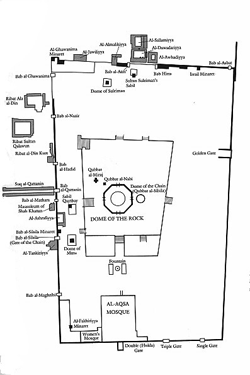
MUST SEE - Feiglin was allowed to visit the Temple Mount for the first time in a year
MK
Moshe Feiglin was allowed to visit the Temple Mount for the first time
in a year, on 19 Adar Alef 5774/Feb. 19, '14. As the representative of
the sovereign and according to the Jewish law principle of 'kibush',
conquering, Moshe Feiglin entered areas of the Temple Mount usually
prohibited by Jewish law.
http://www.youtube.com/watch?v=wMoxHFHiFMY&list=UUOZL13F5YxiMtzUTer8zPYA
http://www.youtube.com/watch?v=wMoxHFHiFMY&list=UUOZL13F5YxiMtzUTer8zPYA
February 26, 2014
Iran & David Duke Salute Presbyterian Church USA
If the Iranian state media and former KKK Grand Wizard David Duke salute your
church’s work, your church is doing something wrong.
The Presbyterian Church (USA) has published a new pamphlet that makes the case against Zionism and therefore, the premise behind Israel’s existence.
The Presbyterian Church (USA) has formidable influence. Its website says it has over 2 million members and 10,000 congregations in the United States. The church’s Israel-Palestine Mission network published the pamphlet, titled Zionism Unsettled: A Congregational Study Guide.
It says:
“It examines the role of Jewish and
Christian forms of Zionism in providing theological and ideological
‘cover’ for the takeover of Palestinian land, and the domination and
dispossession of the Palestinian people during the past one and a
quarter centuries.”
It also criticizes its own church for having a hymn book with a section titled, “God’s Covenant with Israel.”
Iran & david duke - Read More
The Presbyterian Church (USA) has published a new pamphlet that makes the case against Zionism and therefore, the premise behind Israel’s existence.
The Presbyterian Church (USA) has formidable influence. Its website says it has over 2 million members and 10,000 congregations in the United States. The church’s Israel-Palestine Mission network published the pamphlet, titled Zionism Unsettled: A Congregational Study Guide.
It says:
It also criticizes its own church for having a hymn book with a section titled, “God’s Covenant with Israel.”
Iran & david duke - Read More
The Israeli Solution - Caroline Glick

In its annual survey of American Jewry published last October, the American Jewish Committee found that 75 percent of American Jews agree with the statement, “The goal of the Arabs is not a peaceful two-state agreement with Israel, but rather the destruction of Israel."
And yet, American Jews supported the establishment of a Palestinian state 50% to 47%.
In The Israeli Solution, I fill in the blanks that plague the American discourse on Israel and the Palestinians.
I provide a 360-degree analysis of a policy that I call The Israeli One-State Plan. That plan involves applying Israeli law – and through it Israeli sovereignty – throughout all of Judea and Samaria.
I divide the discussion into three parts. Part One provides the 90-year history of failure that has attended the two-state model, from the end of World War I through the present day. I also show how the US’s embrace of the two-state model has worked to blind US policymakers from both parties to the realities of the region and so guaranteed the failure of US Middle East policies.
The Israeli Solution - Read the Rest
Jews Who Abandon Judaism Abandon Israel

Michelle Goldberg of The Nation, the self-described flagship of the left, wrote a piece this week entitled, “Pro-Israel Freakout,” claiming that “The Israel lobby appears to be panicking.” Goldberg details how New York’s Museum of Jewish Heritage cancelled a talk by New Republic senior editor John Judis about his new book, “Genesis: Truman, American Jews, and the Origins of the Arab/Israeli conflict” and then also cancelled a speech by BDS supporter Judith Butler. Rather than using these points to show the strength of the traditional American Jewish community, the author claims “Supporters of the Israeli right are right to worry.” She couldn’t be more wrong.
The reality, despite a hostile Obama Administration, is that the “Israel Lobby” is stronger than ever. The “crisis” which Goldberg describes is that these liberal Jews are no longer interested in remaining Jewish – and of course if they aren’t concerned about Judaism, they are less likely to care about the Jewish state. The continued self-hating narcissism of the Jewish left has them attach tremendous importance to their campaigns.
Abandon Judaism - Read More
Israel and the world is threatened by Iran having nuclear weapons.
http://www.youtube.com/watch?v=-f0PoJhn13g
Israel's population & industrial base are threatened by giving up land in Samaria
http://www.youtube.com/watch?v=ga7X8rFuhmk
Palestine, Bigfoot and other fairy tales
What a welcome breath of fresh air: for the first time in recent
memory, a Muslim scholar in Jordan has had the courage to speak out,
demolishing the mythology and deceit that lie at the heart of the
Palestinian narrative.
In a post on his Facebook page, Sheikh Ahmad Adwan unabashedly declared that Palestine is a fabrication, and that the Land of Israel belongs to the Jewish people.
"I say to those who distort the Koran: from where did you bring the name Palestine, you liars, you accursed, when Allah has already named it 'the Holy Land' and bequeathed it to the Children of Israel until the Day of Judgment?" he wrote.
"There is no such thing as 'Palestine' in the Koran. Your demand for the Land of Israel is a falsehood and it constitutes an attack on the Koran, on the Jews and their land," he said.
Citing verses in the Koran (such as Sura 26, verse 59), Adwan argues that according to the Muslim holy book, Israel was given as an inheritance to the Jewish people and not to anyone else.
While it would be naïve to think that Adwan's pronouncements will bring about any significant change in how the Muslim world relates to Israel, it does offer a timely reminder of an important historical truth.
To put it simply: Palestine and the Palestinians are a modern invention, a fiction created with the aim of dismantling Israel and undermining its claim to its ancient patrimony.
The myth of Palestine is the diplomatic equivalent of Bigfoot, the Loch Ness Monster and the Abominable Snowman. Although plenty of people may persist in believing in these fairy tales, that doesn't make them true.
Indeed, prior to the 1947 UN partition plan, even Palestinian Arab leaders openly affirmed this to be the case.
Palestine - Read More
In a post on his Facebook page, Sheikh Ahmad Adwan unabashedly declared that Palestine is a fabrication, and that the Land of Israel belongs to the Jewish people.
"I say to those who distort the Koran: from where did you bring the name Palestine, you liars, you accursed, when Allah has already named it 'the Holy Land' and bequeathed it to the Children of Israel until the Day of Judgment?" he wrote.
"There is no such thing as 'Palestine' in the Koran. Your demand for the Land of Israel is a falsehood and it constitutes an attack on the Koran, on the Jews and their land," he said.
Citing verses in the Koran (such as Sura 26, verse 59), Adwan argues that according to the Muslim holy book, Israel was given as an inheritance to the Jewish people and not to anyone else.
While it would be naïve to think that Adwan's pronouncements will bring about any significant change in how the Muslim world relates to Israel, it does offer a timely reminder of an important historical truth.
To put it simply: Palestine and the Palestinians are a modern invention, a fiction created with the aim of dismantling Israel and undermining its claim to its ancient patrimony.
The myth of Palestine is the diplomatic equivalent of Bigfoot, the Loch Ness Monster and the Abominable Snowman. Although plenty of people may persist in believing in these fairy tales, that doesn't make them true.
Indeed, prior to the 1947 UN partition plan, even Palestinian Arab leaders openly affirmed this to be the case.
Palestine - Read More
The Middle East’s Real Apartheid State : House of Saud
There is a country in the Middle East where 10 percent of the population is denied equal rights because of their race, where black men are not allowed to hold many government positions, where black women are put on trial for witchcraft and where the custody of children is granted to the parent with the most “racially superior” bloodline.
This Apartheid State is so enormously powerful that it controls American foreign policy in the Middle East even as its princes and princesses bring their slaves to the United Kingdom and the United States.
That country is Saudi Arabia.
Saudi Arabia abolished slavery in 1962 under pressure from President Kennedy, who accomplished what the Ottoman Empire and the League of Nations had not been able to, but that hasn’t stopped its citizens from selling castrated slaves on Facebook or its princes from beating their black slaves to death in posh London hotels.
The Saudis had clung to their racist privileges longer than anyone else. When rumors reached Mecca that the Ottoman Empire might be considering the abolition of African slavery and equal rights for all, the chief of the Ulema of Mecca issued a fatwa declaring “the ban on slaves is contrary to Sharia (Islamic Law)… with such proposals the Turks have become infidels and it is lawful to make their children slaves.”
But Saudi Arabia’s oil wealth eventually made slavery economically unnecessary. Early on, African slaves worked for foreign oil companies which paid their masters, but they were a poor fit for the oil economy. The Kingdom no longer needed agricultural slaves and pearl drivers; it needed trained technicians from the West and international travel made it cheaper to import Asian workers for household labor and construction than to maintain its old trade in slaves.
The Saudis replaced the 450,000 slaves of the 1950s with 8.4 million guest workers. These workers are often treated like slaves, but they are not property and are therefore even more disposable than the slaves were. Exact numbers are hard to come by, but Nepal alone reported 265 worker deaths in Saudi Arabia in a single year.
Human Rights Watch has described conditions for foreign workers in Saudi Arabia as resembling slavery.
House of Saud - Read More
This Apartheid State is so enormously powerful that it controls American foreign policy in the Middle East even as its princes and princesses bring their slaves to the United Kingdom and the United States.
That country is Saudi Arabia.
Saudi Arabia abolished slavery in 1962 under pressure from President Kennedy, who accomplished what the Ottoman Empire and the League of Nations had not been able to, but that hasn’t stopped its citizens from selling castrated slaves on Facebook or its princes from beating their black slaves to death in posh London hotels.
The Saudis had clung to their racist privileges longer than anyone else. When rumors reached Mecca that the Ottoman Empire might be considering the abolition of African slavery and equal rights for all, the chief of the Ulema of Mecca issued a fatwa declaring “the ban on slaves is contrary to Sharia (Islamic Law)… with such proposals the Turks have become infidels and it is lawful to make their children slaves.”
But Saudi Arabia’s oil wealth eventually made slavery economically unnecessary. Early on, African slaves worked for foreign oil companies which paid their masters, but they were a poor fit for the oil economy. The Kingdom no longer needed agricultural slaves and pearl drivers; it needed trained technicians from the West and international travel made it cheaper to import Asian workers for household labor and construction than to maintain its old trade in slaves.
The Saudis replaced the 450,000 slaves of the 1950s with 8.4 million guest workers. These workers are often treated like slaves, but they are not property and are therefore even more disposable than the slaves were. Exact numbers are hard to come by, but Nepal alone reported 265 worker deaths in Saudi Arabia in a single year.
Human Rights Watch has described conditions for foreign workers in Saudi Arabia as resembling slavery.
House of Saud - Read More
February 24, 2014
The Artificiality of the Historical Palestinian Identity
The
artificiality of a Palestinian identity is reflected in the attitudes
and actions of neighboring Arab states that never established a
Palestinian state or advocated one prior to the Six-Day War in 1967.
What unites Palestinian Arabs has been their opposition to Jewish
nationalism and the desire to stamp it out, not aspirations for their
own state. Local patriotic feelings are generated only when a
non-Islamic entity takes charge – such as Israel did in 1967 after the
Six-Day War, and dissipates under Arab rule, as it was under the rule of
Jordan prior to 1967.
Culturally,
Palestinians are not distinct from other Arabs. The sole contributions
Palestinians can take credit for are the invention of skyjacking for
political purposes in the 1960s, and a special brand of suicidal
terrorism that uses their own youth as delivery systems for bombing
pizza parlors, discos, and public commuter buses.
URGENT - Resolution declaring that Israel is the sovereign on the Temple Mount.
Urgent Call to Action! It
is imperative that all the nationalist MKs attend this historic Knesset
deliberation and vote for the proposed resolution declaring that Israel
is the sovereign on the Temple Mount. The MKs are under tremendous
pressure not to attend. They need all the support and encouragement they
can get. Please send emails (English is fine) to the nationalist MKs. Click here for the list, send your emails to the MKs and get the word out on your social media. Together we will make history!
.
Tuesday, 25Adar Alef/Feb. 25
12 PM-
As part of an ongoing trend to get people to eat healthy food Moshe
will participate in a Vegan food tasting ceremony & fair in the
Knesset featuring a world class Israeli Chef
3 PM - Will participate in the "Land of Israel Caucus" meeting to discuss key issues re: Yehuda and Shomron
5 PM-
Here is the meeting of the week: At Moshe's request a full discussion -
the first of its kind since 1967 - will take place in the Knesset
plenum concerning the de facto transfer of sovereignty on the Temple
Mount to the Muslim Wakf (Jordan) and the discrimination against Jews .
The media has been covering this quite extensively and Moshe has given
dozens of interviews already, with many more scheduled every day! This
is a historic vote and one which we MUST WIN!!!February 21, 2014
The Question the "Palestinians" Aren’t Being Asked

Almost all the focus in the mainstream media on the Middle East peace process tends to be on the decision taken by only one of the parties involved in the negotiations.
The perennial question from pundits and even veteran kibitzers like The New York Times’s Thomas Friedman is whether Israelis are ready to take risks in order to achieve peace.
That was the conceit of a column he wrote last week titled “Israel’s Big Question,” and if it seemed familiar to readers, it was no accident. Friedman has been writing the same column for decades in which he asks Israelis whether they will leave the West Bank in order to retain both the Jewish and democratic identities of their nation. If they don’t, and Secretary of State Kerry’s initiative fails, Israel’s doom is, he says, sealed. But of course Israel has already tried to trade land for the promise of peace and failed. The Palestinians turned down three offers of statehood and there is every indication they will turn down a fourth offer of up to 90 percent of the West Bank that is being mulled by the Netanyahu government.
Friedman’s assumption – as well as that of many of Israel’s critics – is that if the Israelis are sufficiently forthcoming those problems will disappear. They should instead be asking what it is about the political culture of the Palestinians that makes their intransigence not merely possible but inevitable. The answer comes in two separate stories that touch on what it is that both the PA’s negotiators and Hamas believe.
In Gaza, the Hamas government has apparently rejected the textbooks provided for schools by UNRWA, the United Nations agency that serves Palestinian refugees and their descendants. UNRWA has hired Hamas terrorists as staffers and has been rightly accused of helping to perpetuate the conflict by not seeking to resettle refugees so as to keep them in camps as props in the long Arab war against Israel. But while the textbooks UNRWA has published for Gaza schools apparently accept the Palestinian narrative of victimization and the illegitimacy of Israel, they also encourage non-violence. The Hamas education ministry is particularly angry since the books emphasize the examples of peaceful protests.
Education Minister Mu’tasim Al-Minawi had the following objections: “The vast majority of examples [in the books] refer to [Mahatma] Gandhi, Martin Luther King, Rosa Parks, Helen Suzman, the Soweto Uprising, the Magna Carta and Apartheid, even though Islamic-Arab-Palestinian alternatives exist. There are many models which could be used which are closer to the students’ understanding.”
This tells us Hamas is educating the children of Gaza not just to hate Israel and Jews but also to reject the Western frame of reference about human rights, even in the context of support for anti-Israel activism, which was clearly the intention of the UNRWA curriculum.
Also instructive is the mini-controversy inspired by Saeb Erekat, the man who represents the Palestinians in peace talks. Earlier this month at the Munich Security Conference, Erekat told his Israeli counterpart Tzipi Livni that asking him to recognize the Jewish state was impossible since it would force the Palestinians “to change their narrative” about their history. He also claimed his family – as well as the rest of the Palestinians – has a claim to the land prior to that of the Jews since they are descended from the biblical Canaanites and were there when Joshua Bin Nun “burned my hometown Jericho.”
Suffice it to say that there is no evidence that Palestinian Arabs have any connection with the inhabitants of the country prior to the Arab conquest that occurred in the seventh century CE.
But if even Erekat – whom we are told by the media and the U.S. government is a man of peace – is determined to cling to a historical narrative that is based in rejection of Jewish rights to any part of the country, then what hope is there for peace?
Both Fatah and Hamas continue to educate their peoples in a culture that is not only steeped in hatred of Jews and Israel but in a worldview in which the rejection of Zionism is integral to Palestinian identity. The question Kerry, Friedman, and others who continue to hound Israel should be asking is this: When will the Palestinians give up their culture of hate and embrace one that would give peace a chance?
Read more at: http://www.jewishpress.com/indepth/opinions/the-question-the-palestinians-arent-being-asked/2014/02/20/
Almost all the focus in
the mainstream media on the Middle East peace process tends to be on
the decision taken by only one of the parties involved in the
negotiations.
The perennial question from pundits and even veteran kibitzers like The
New York Times’s Thomas Friedman is whether Israelis are ready to take
risks in order to achieve peace. That was the conceit of a column he
wrote last week titled “Israel’s Big Question,” and if it seemed
familiar to readers, it was no accident. Friedman has been writing the
same column for decades in which he asks Israelis whether they will
leave the West Bank in order to retain both the Jewish and democratic
identities of their nation. If they don’t, and Secretary of State
Kerry’s initiative fails, Israel’s doom is, he says, sealed.
But of course Israel has already tried to trade land for the promise of
peace and failed. The Palestinians turned down three offers of statehood
and there is every indication they will turn down a fourth offer of up
to 90 percent of the West Bank that is being mulled by the Netanyahu
government.
Friedman’s assumption – as well as that of many of Israel’s critics – is
that if the Israelis are sufficiently forthcoming those problems will
disappear. They should instead be asking what it is about the political
culture of the Palestinians that makes their intransigence not merely
possible but inevitable. The answer comes in two separate stories that
touch on what it is that both the PA’s negotiators and Hamas believe.
In Gaza, the Hamas government has apparently rejected the textbooks
provided for schools by UNRWA, the United Nations agency that serves
Palestinian refugees and their descendants. UNRWA has hired Hamas
terrorists as staffers and has been rightly accused of helping to
perpetuate the conflict by not seeking to resettle refugees so as to
keep them in camps as props in the long Arab war against Israel. But
while the textbooks UNRWA has published for Gaza schools apparently
accept the Palestinian narrative of victimization and the illegitimacy
of Israel, they also encourage non-violence. The Hamas education
ministry is particularly angry since the books emphasize the examples of
peaceful protests.
Education Minister Mu’tasim Al-Minawi had the following objections: “The
vast majority of examples [in the books] refer to [Mahatma] Gandhi,
Martin Luther King, Rosa Parks, Helen Suzman, the Soweto Uprising, the
Magna Carta and Apartheid, even though Islamic-Arab-Palestinian
alternatives exist. There are many models which could be used which are
closer to the students’ understanding.”
This tells us Hamas is educating the children of Gaza not just to hate
Israel and Jews but also to reject the Western frame of reference about
human rights, even in the context of support for anti-Israel activism,
which was clearly the intention of the UNRWA curriculum.
Also instructive is the mini-controversy inspired by Saeb Erekat, the
man who represents the Palestinians in peace talks. Earlier this month
at the Munich Security Conference, Erekat told his Israeli counterpart
Tzipi Livni that asking him to recognize the Jewish state was impossible
since it would force the Palestinians “to change their narrative” about
their history. He also claimed his family – as well as the rest of the
Palestinians – has a claim to the land prior to that of the Jews since
they are descended from the biblical Canaanites and were there when
Joshua Bin Nun “burned my hometown Jericho.”
Suffice it to say that there is no evidence that Palestinian Arabs have
any connection with the inhabitants of the country prior to the Arab
conquest that occurred in the seventh century CE.
But if even Erekat – whom we are told by the media and the U.S.
government is a man of peace – is determined to cling to a historical
narrative that is based in rejection of Jewish rights to any part of the
country, then what hope is there for peace?
Both Fatah and Hamas continue to educate their peoples in a culture that
is not only steeped in hatred of Jews and Israel but in a worldview in
which the rejection of Zionism is integral to Palestinian identity. The
question Kerry, Friedman, and others who continue to hound Israel should
be asking is this: When will the Palestinians give up their culture of
hate and embrace one that would give peace a chance?
Read more at: http://www.jewishpress.com/indepth/opinions/the-question-the-palestinians-arent-being-asked/2014/02/20/
Read more at: http://www.jewishpress.com/indepth/opinions/the-question-the-palestinians-arent-being-asked/2014/02/20/
The Wisdom of Women
“Behind every good man is an even better woman”. We have all
heard this expression and probably have complimented our wives with it.
We may have used it as a form of flattery even with the noblest of intentions. We may have even spun the facts to make her feel cherished and appreciated.
However, the special wisdom and virtue of women is not simply a societal invention but a fact and a truth.
The Talmud of Eretz Yisrael teaches us in an enigmatic statement that God gave half of the ‘yod’ from Sarah gave it to Abraham (Sanhedrin 2:6).
The ‘yod’ has a numerical value of ten while the ‘he’ has a numerical value of five. The ‘yod’ in שרי was split in half resulting in שרהand אברהם.
God imparted some of Sarah’s gist onto Abraham and not the other way around! It was Sarah who made Abraham who he was but it was not Abraham who made Sarah who she was.
Sarah’s gist empowered Abraham and as a testimony to this, her gist remained forever symbolically stamped on his name. It is this gist which allowed Abraham to become the great person that he was.
May we embrace our women and appreciate their special wisdom and righteousness and how they have influenced us to developing whatever great traits we may possess.
http://www.ou.org/torah/machshava/lessons-from-eretz-yisrael/wisdom-women/
We may have used it as a form of flattery even with the noblest of intentions. We may have even spun the facts to make her feel cherished and appreciated.
However, the special wisdom and virtue of women is not simply a societal invention but a fact and a truth.
The Talmud of Eretz Yisrael teaches us in an enigmatic statement that God gave half of the ‘yod’ from Sarah gave it to Abraham (Sanhedrin 2:6).
The ‘yod’ has a numerical value of ten while the ‘he’ has a numerical value of five. The ‘yod’ in שרי was split in half resulting in שרהand אברהם.
God imparted some of Sarah’s gist onto Abraham and not the other way around! It was Sarah who made Abraham who he was but it was not Abraham who made Sarah who she was.
Sarah’s gist empowered Abraham and as a testimony to this, her gist remained forever symbolically stamped on his name. It is this gist which allowed Abraham to become the great person that he was.
May we embrace our women and appreciate their special wisdom and righteousness and how they have influenced us to developing whatever great traits we may possess.
http://www.ou.org/torah/machshava/lessons-from-eretz-yisrael/wisdom-women/
February 20, 2014
Get Serious - Obama, Release Jonathan Pollard NOW
By Moshe Feiglin Translated from Makor Rishon
We
have reached the red line for Jonathan Pollard. If the President of the
United States, Barack Hussein Obama, doesn’t bring our brother,
Jonathan, who has been captive in his country for 28 years, with him to
Israel – he is liable to die in prison, G-d forbid. With this heavy
ethical weight on our necks, this horrible betrayal of an agent that we
sent to risk his life for us, we may all be thrown into a reality that
begins with a “small” destruction at Ma’aleh Rehavam and ends – who
knows where?
In the end, we will find ourselves without Pollard, without Judea and Samaria, without the Americans and with a nuclear Iran. Just like in the Lodz ghetto, where they gave a few poor children to save all the rest. Nothing has changed since then. The Jews are the same Jews and the mindset is the same, as well.
Today, I called upon my fellow Knesset Members to boycott Obama’s Knesset speech if he does not bring our brother, Jonathan, with him. In the meantime, in the face of the approaching tsunami, we are all busy bickering over the proverbial tempests in the teapot.
When it comes to the Haredi draft issue, I don’t know if I should laugh or cry. After all, the last thing that Lapid wants is for the IDF to suddenly grow a long beard and put on a black suit. And the IDF does not want or need the extra manpower. The IDF already drafts many more recruits than it really needs. On the other side of the coin, there are many young Haredi men who want to serve in the army, work and lead normal lives. The problem is that the IDF does not offer them enough frameworks that are appropriate to their level of observance. Nobody actually expects them to exercise with women instructors. So what is the debate really all about? Rating, and political capital.
The second tempest in the teapot is jump-starting the “peace” process. What are they talking about? In all of history, there has never been a collection of people for whom the entire world, including those who should surrender their sovereignty, has rallied full force to establish a state– and the state has not been born. A “Palestinian” state will never be born because Golda Meir was right. There is no “Palestinian” nation and this non-nation harbors a primal fear of a state. Just look how Ahmad Tibi and Co. reacted when FM Lieberman made his generous offer to move the border west of their towns, effectively removing them from Israel proper.
The goal of “Palestinian” self-definition is not sovereignty in the Land of Israel, but rather, the negation of Jewish sovereignty in the Land. That is why a “Palestinian” state has never been established in Judea and Samaria and why there was never such a demand when Jordan or any other Moslem entity ruled here. Their focus has always been on the very last centimeter of Jewish sovereignty in the Land of Israel. As the British Foreign Minister, Ernest Bevin defined the issue at the League of Nations when the British returned their mandate over the Land of Israel to the world body: “The goal of the Jews in the Land of Israel is to establish a state for the Jews in the Land. The goal of the Arabs in the Land of Israel (he did not say “Palestinians”) is to ensure that the Jews do not establish a state in the Land of Israel.”
The tsunami is approaching, and the Jews in the Land of Israel are fighting over total non-issues. If it weren’t so sad, it would be comical. It’s time to get serious.
Subscribe to:
Posts (Atom)

